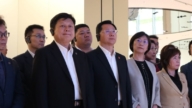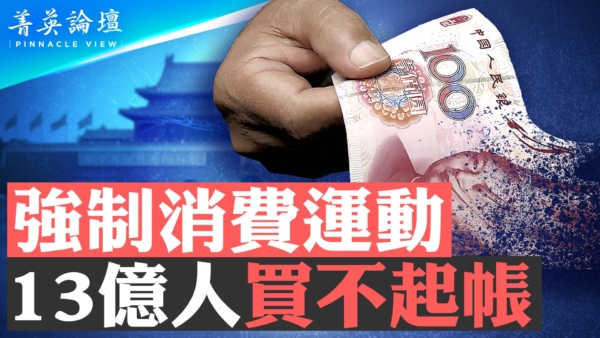【新唐人2014年02月19日讯】2013年中国公共财政收入达到12万9000亿,人均宏观税负接近万元。不少人听到这样的数据都感到恐慌。以官方公布的数据来计算,2012年城镇居民人均可支配收入24565元,农村居民人均纯收入7917元,也就是民众的收入有将近一半是贡献给政府了。对此,中共财政部的官员说,还是太少了。
根据“中国社会科学院财经战略研究院”发布报告显示,2013年中国公共财政收入达到12万9000亿,人均宏观税负接近万元。
税负是税收负担的简称,有宏观和微观之分。“宏观税负”是从政府角度看税收负担,指的是一个国家或地区在一定时期内的税收总额,占同期国内生产总值(GDP)的比例。而“微观税负”是指企业或个人纳税和收入的比率。
中国政法大学财税法研究中心主任施正文:“这个收入占GDP的18%左右,这个小口径的税负收入,税负的比重从国际上来看应该是不高,发达国家应该是30、40%。”
高税国家,比如瑞典,税收占GDP的51%,比如美国,税收占GDP的27%。而中国的税收只占GDP的18%左右。
但是,在瑞典,孩子上学不交一分钱,因为大家都缴了税。丹麦也是个高税率国家,税收占到收入的50%-70%。但政府包揽了所有国民的医疗和教育费用。在美国,大学前教育的公立学校学费都是免费的。
施正文:“中国毕竟现在还不是一个开发国家,GDP发展指数还是维持是中等水平,财政的管理水平也不是很高,那么按照这样的情况来看,应该说我们的税负是有点偏高。”
“公共财政收入”是衡量“宏观税负”各指标中,口径最小的一个,还不包括数不清的各种费,中共的税务部门也从来没有给出过具体解释。
大陆博客作家蔡慎坤的文章写到,中国税制与国外税制的一个重大区别,就是政府的财政收入除税收之外,还有包括预算内收费、预算外收入、制度外收入等等。把这些收入统统加起来与GDP相比较,才是真正的“宏观税负”。如果再把制度“之外”的乱收费、乱罚款、乱摊派,还有形形色色的腐败贿赂支出,以及因通货膨胀而提高的实际税率,那就根本算不清楚税负水准到底是多少了。
他认为,全民“高税负”换来的只是“低福利”甚至是“无福利”,“取之于民”的税收,只用于少数人挥霍,乃至被各种豆腐渣工程所吞噬,那才是全民的悲哀!
大陆金融投资顾问郑先生:“这个设计统计的方法和角度不一样,不同的统计机构,他统计出来的数据是不同的,政府要做的事情,只是在回避和淡化,甚至是掩饰,但客观就是这样,就产生资本外流,产生那些有钱人没有安全感。”
报告的资料显示,中国九成以上的税收来自企业缴纳。中国大量民营企业家抱怨税高、负担重,为了寻求资金上更健全的制度、为了自身的安全感与子女的教育,他们选择投资移民海外。
郑先生:“如果民众的负担过大的话,他没有钱,不能藏赋予民,那么市场的消费如何振兴、市场如何繁荣?我们的税收,我们的钱怎么花?一直缺乏监管和透明,怎么样建立一种制度化的监管和约束机制,这才是我们应该要着手。”
根据美国《福布斯》杂志推出的“税负痛苦指数”排名,中国大陆位居全球第二。事实上,早在春秋时代,著名思想家管仲就提出警告,“取于民有度,用之有止,国虽小必安﹔取于民无度,用之不止,国虽大必危”。
事实上,缴税多寡不是让人痛苦的主要原因,关键是税收是否公平?税收收入用在何方?到底有多少是用在人民身上?或许这才是“税负痛苦指数”高居不下的关键所在。
采访/常春 编辑/黄亿美 后制/郭敬
Communist Officials Say Chinese Tax Burden Is too Little
In 2013, China collected public revenue of 12.9 billion, and on
a per capita basis, the macro-tax burden is calculated at nearly
10,000 yuan.
This figure shocked many.
The official data suggested that, at the 24,565 yuan disposable
income of urban residents and 7,917 yuan of rural residents
in 2012, half of the income was contributed to the government.
The Communist Treasury officials claimed, it’s still too little.
National Academy of Economic Strategy, Chinese Academy
of Social Sciences (CASS), reported recently that,
the 2013 total revenue of 12.9 billion suggested a macro-tax
burden of nearly 10,000 yuan for the Chinese.
There are macro and micro factors when it comes to the tax
burden.
The macro-tax burden refers to the ratio of revenue raised by
the entire country or region in a given period to the GDP,
whereas the micro-tax burden refers to the ratio of an industry
or personal tax to the gross income.
Shi Zhengwen, Professor in the School of Civil, Commercial,
and Economic Laws, China University of Political Science
and Law:
“This revenue is accounted for about 18% GDP, which is
relatively low comparing to the international community.
The developed countries should be around 30% to 40 %."
In high-tax countries such as Sweden, revenues from taxes
are accounted for 51% GDP.
The tax revenue in the United States is accounted for 27% GDP.
China’s tax revenue is only about 18% GDP.
However, in Sweden, the children go to school for free.
Denmark is also a high-tax country. The taxes are accounted
for 50 % to 70 % of the GDP.
However, the government also covers the health care and
education costs.
In the U.S., the free public schools provide basic school supplies,
after-school program and free lunch to the majority of students.
The ambulance is also free.
Shi Zhengwen: “China, after all, is not a developed country.
According to its moderate GDP and the far from sufficient
financial management, the tax burden is a little too high."
In China, the public revenue is the smallest caliber measure
index of the macro-tax burden.
The Communist tax department has never explained in
concrete details of all measurement indices .
The Chinese blog writer, Cai Shenkun, wrote that a significant
tax difference between China and other countries is that,
other than tax revenue, there is also revenue from governmental
budget fees and charges outside the budget, in China’s system.
The total of these in comparison to the GDP is the real macro-tax
burden.
Considering the chaotic charges outside the system, such as fines
and expenses on all kinds of corruptions and bribery,
as well as the high taxes due to inflation, the tax burden is hard
to calculate.
He believes that in return for the high tax burden is the low
welfare or even no welfare.
The taxes collected from the people are only usable by the few
or even swallowed by various shabby constructions.
It is the sorrow of all of China.
Mr. Cheng, a finance consultant in China: “Given the different
statistical methods and approaches, the data will be different.
What the government is doing is actually to devoid, simplify,
or even cover up.
In reality, it leads to capital outflows and lack of security for
the wealthy class."
The CASS report showed that more than 90% of China’s tax
revenue came from corporate tax.
The majority of Chinese private entrepreneurs complain about
heavy taxes, and choose business emigration for a better financial
system, security and education.
Mr. Cheng: “How can the market revitalize if people are
burdened with heavy taxes?
It lacks supervision and transparency about how our taxes
have been utilized.
What we need is to build a systematic supervision and restraint
and how to build it."
According to Forbes Tax Misery Index, China ranks second
in the world.
In fact, as early as the Spring and Autumn Period in
Chinese history, the famous thinker Guan Zhong had warned,
“Take from the people with constraint, and use it with a purpose,
the state will be safe, though small;
take excessively from the people, and use it without restriction,
the state is at risk, though great."
In fact, the amount of taxes is not the key to the misery.
The key is that if the tax is fair, where it’s used, and how much
it’s used on the people.
Perhaps these are the causes of why China’s tax misery index
has been so high for years.
Interview/ChangChun Edit/HuangYimei Post-Production/GuoJing




























